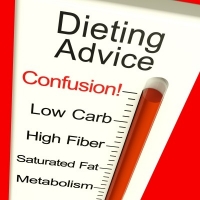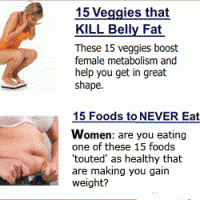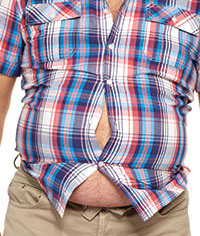Lose Weight > Weight Loss Tips > Weight Loss Articles > How Retired Athletes Can Win The Big Game Against Fat
How Retired Athletes Can Win The Big Game Against Fat
Ever look at one of your favorite retired NFL stars only to say, "What happened to him?" Or even worse, you are a retired athlete looking in the mirror asking, "What happened to me!"
It may surprise you to know you're in good company. You are a member of a big club, the overweight retired athletes club. Thousands of retired athletes have found themselves battling the bulge as they age, just like you. Faster than Joe Montana can throw a ball into the end zone, the weight comes on, and on and on.
You take out the old photo album and flip the sheets. A smile comes across your face for a fleeting second only to collapse into a frown. Look at that stud, thin, strong, fast, ah... the good old days, here today gone tomorrow. And what about that blood profile report sitting under the remote and half empty Nacho plate on the coffee table? Can it really be true that you are now on the verge of diabetes? How the heck did that happen?
The doc told you to eat right and exercise and maybe, just maybe all you'll need are the pills. That was a bit of a relief considering you hate needles. That always amused your kids, big tough Dad, hates needles. You look across the living room into the doorway of the gym and there it sits with your old #18 jersey draped across the hand holds, the treadmill. As fast as you spy the equipment the pain in your knee shoots through you like a bullet, must be time for another Naproxen. How you hate getting older. If it wasn't for that stupid knee you could play again and all these problems would disappear! How you wish you could play again. Oh well you're doing the best you can. You exercise as much as the pain will allow and you're still following your player's diet. You finally come to the conclusion that genetics and your knee have caught up to you and you're destined to be the big guy in the house. It's outside of your control and anyway, wishes are for kids.
Well get ready big guy because today I'm going to make your wish come true! Today you're coming off the bench, it's time to play again and this time the prize will be bigger and better than a Super Bowl ring. Your pot of gold at the end of this season will be the return of your good health! There's a new coach in town and it's time for you to play again, only this battle will be an off field game. Don't worry. You'll see the field again, in due time.
This game has one simple play: take out the opposing quarterback and score.
Let's talk strategy. Your opposing team is your blood profile, the quarterback is sugar. It's that quarterback, not your knee, that's causing you all your problems. Sugar is causing your weight gain, your inability to lose weight and your Diabetes. Every single pound of extra weight you carry puts 4 pounds of pressure on your knee! Blood sugar (glucose) is your fuel: you burn it every day all day long even when you sleep. What you don't burn gets stored as future fuel (FAT). Our strategy is simple: get a handle on your blood sugar, the fat will melt away, your diabetes will reverse, your knee will hurt a whole lot less and you'll fit back into that #18 jersey.
So are you ready to get off the bench and back into the game? Let's play!
SUGAR IS YOUR ENEMY!
Sugar is what is making you fat, and it's coming into your body from many different sources. Your body uses what it needs and then turns the rest into fat. Once you know where all the sugar is coming from and understand what happens to it once it's in your body, you can start to make adjustments.
Refined sugar is found in processed foods, soda, candy, cookies, cake, ice cream, and any other products using it as an added ingredient. Refined sugar is a simple carbohydrate. The body burns it for fuel before it will burn anything else by immediately turning it into glucose (blood sugar).
Sugar from fruits, fructose, is also a simple carbohydrate. The body burns simple carbohydrates first for fuel before ever getting close to burning stored fat. Fructose metabolizes slower because the liver converts it to glycogen prior to glucose.
Sugar from vegetables and grains is a complex carbohydrate and burns more slowly than the simple carbohydrate. Although it burns more slowly, in excess complex carbohydrates will also cause fat gain. In excess happens more quickly with grains than with vegetables. Grains get turned into flour, flour gets turned into breads and pasta, and bread and pasta break back down to sugar in your body. (I bet you eat lots of bread and other flour products, such as pasta.) Grains also get turned into cereal, and cereal breaks back down to sugar in your body. (I'll bet you eat a lot of cereal. You may even put a high-sugar fruit on top along with a teaspoonful of table sugar.)
Sugar is going into your system at an alarming rate. It's in your vegetables, fruits, processed foods, snacks, condiments, beverages, breads, and flour. Americans live on sugar. I mean that literally when I say it. Sugar and added sugars are the main fuel of the American public! According to U.S. Department of Agriculture (USDA) data, sugar consumption in 1999 was 158 pounds per person! And sugar consumption is on the rise. In 1983, each of us ate 113 pounds of the stuff. Our consumption has risen every year but one since 1983. The USDA surveys indicate that the 158 pound figure is equivalent to about 50 teaspoons of sugar per day!
What is the result of all this sugar? Over the last 20 years in the U.S., we have seen a 100 percent increase in obesity rates in children and adolescents. Added sugars include regular table sugar derived from sugarcane and sugar beets (sucrose), corn syrup, high-fructose corn syrup, corn sugar (glucose), honey, and others. These figures do not include the sugars in milk, high fructose fruits, and high sugar content vegetables.
All this sugar consumption over the years has created a vicious cycle for those of us addicted to sugar. The more sugar we eat, the more sugar we crave. As with the tobacco industry, it's the cravings that the sugar industry counts on to continue building its bottom-line profits.
How about the hidden sugar in our food? This is the sugar coming into our bodies from high-sugar foods, such as fruits and vegetables. They come in the form of simple and complex carbohydrates. Here's the formula:
Four grams of carbohydrates metabolize the same as four grams of sugar. To give you a visual, four grams of sugar equals one level teaspoon.
So, how does our food rate in teaspoons of sugar? Let's analyze the sugar content in a medium order of fast-food French fries.
One of the purposes of your digestive tract is to break down the starch and other complex carbohydrates - which are simply chains of sugar molecules - into their component sugars so they can be absorbed into the blood. Our medium order of fries contains 47 grams of carbohydrates. Those 47 grams of carbohydrates metabolize the same as 47 grams of sugar - almost 12 teaspoons! 12 teaspoons of sugar, just from the fries!
Now let's see what happens when we add a large soft drink, a hamburger bun, and a dessert:
Sugar from fries 12 teaspoons
Sugar from soda 14 teaspoons
Sugar from bun 6 teaspoons
Sugar from peach pie 11 teaspoons
TOTAL SUGAR INTAKE: 43 teaspoons!
Imagine what happens to the counts when we "super size" our orders. No wonder the obesity and type 2 diabetes problems in the U.S. are running at epidemic levels. Eating this lunch is the equivalent of sitting down in front of your sugar bowl and eating 43 teaspoons of sugar - almost one full cup!
The only ingredient in the lunch that was sugar-free and good for you was the meat in the bun! Now let's take a look at a typical breakfast.
2 cups of corn flakes = 12 teaspoons of sugar
1 normal size banana = 6 teaspoons of sugar
2 pieces of toast = 8 teaspoons of sugar
2 tablespoons of jelly = 7 teaspoons of sugar
4 oz of milk on cereal = 1.5 teaspoons of sugar
6 oz box of orange juice = 5.5 teaspoons of sugar
TOTAL sugar intake: 40 teaspoons!
Could you imagine how gross it would be to sit in front of your sugar bowl and eat 40 teaspoons of sugar? But that's exactly what you're doing when you eat this breakfast.
What about pizza? Pizza is one of our favorite foods. There can't be any sugar in pizza...right? Sorry! Let's take a look at a trip to the pizza parlor.
Pizza Hut 4-for-all Pizza Supreme
Whole pizza = 14.5 teaspoons of sugar
pizza for you = 7.25 teaspoons of sugar
24 oz Soda = 19 teaspoons of sugar
TOTAL SUGAR INTAKE: 26.25 teaspoons!
If you ate that breakfast, that lunch, and then a pizza dinner, it would be the equivalent of eating 109 teaspoons of sugar. That's over 2 cups!
Now you see the problem with the American diet, and probably your diet. The problem is that our bodies are not burning all the food we eat, let alone our excess fat. Our bodies are burning the crazy amount of sugar in our foods. The result is, all the sugar that doesn't get burned turns into what? You guessed it: more stored fat!
If you want to lose weight, your body needs to burn the stored sugar (fat) for fuel. In order to get the body to do that, we simply have to cut off the sugar pipeline. This forces the body to attack those big, fat flabby deposits dangling around our bodies and as a bonus balances our blood sugar. Cut off the sugar and you'll cut off the fat and balance your blood sugar. It's that simple.
So, how do we get rid of the sugar? Easy. While you're in weight-loss mode, stay away from all the foods that metabolize into blood sugar and stick with proteins, fats and green veggies. Remember this rule:
MEATS AND GREENS WILL MAKE YOU LEAN - SUGAR AND CARBS WILL MAKE YOU LARGE.
It may surprise you to know you're in good company. You are a member of a big club, the overweight retired athletes club. Thousands of retired athletes have found themselves battling the bulge as they age, just like you. Faster than Joe Montana can throw a ball into the end zone, the weight comes on, and on and on.
You take out the old photo album and flip the sheets. A smile comes across your face for a fleeting second only to collapse into a frown. Look at that stud, thin, strong, fast, ah... the good old days, here today gone tomorrow. And what about that blood profile report sitting under the remote and half empty Nacho plate on the coffee table? Can it really be true that you are now on the verge of diabetes? How the heck did that happen?
The doc told you to eat right and exercise and maybe, just maybe all you'll need are the pills. That was a bit of a relief considering you hate needles. That always amused your kids, big tough Dad, hates needles. You look across the living room into the doorway of the gym and there it sits with your old #18 jersey draped across the hand holds, the treadmill. As fast as you spy the equipment the pain in your knee shoots through you like a bullet, must be time for another Naproxen. How you hate getting older. If it wasn't for that stupid knee you could play again and all these problems would disappear! How you wish you could play again. Oh well you're doing the best you can. You exercise as much as the pain will allow and you're still following your player's diet. You finally come to the conclusion that genetics and your knee have caught up to you and you're destined to be the big guy in the house. It's outside of your control and anyway, wishes are for kids.
Well get ready big guy because today I'm going to make your wish come true! Today you're coming off the bench, it's time to play again and this time the prize will be bigger and better than a Super Bowl ring. Your pot of gold at the end of this season will be the return of your good health! There's a new coach in town and it's time for you to play again, only this battle will be an off field game. Don't worry. You'll see the field again, in due time.
This game has one simple play: take out the opposing quarterback and score.
Let's talk strategy. Your opposing team is your blood profile, the quarterback is sugar. It's that quarterback, not your knee, that's causing you all your problems. Sugar is causing your weight gain, your inability to lose weight and your Diabetes. Every single pound of extra weight you carry puts 4 pounds of pressure on your knee! Blood sugar (glucose) is your fuel: you burn it every day all day long even when you sleep. What you don't burn gets stored as future fuel (FAT). Our strategy is simple: get a handle on your blood sugar, the fat will melt away, your diabetes will reverse, your knee will hurt a whole lot less and you'll fit back into that #18 jersey.
So are you ready to get off the bench and back into the game? Let's play!
SUGAR IS YOUR ENEMY!
Sugar is what is making you fat, and it's coming into your body from many different sources. Your body uses what it needs and then turns the rest into fat. Once you know where all the sugar is coming from and understand what happens to it once it's in your body, you can start to make adjustments.
Refined sugar is found in processed foods, soda, candy, cookies, cake, ice cream, and any other products using it as an added ingredient. Refined sugar is a simple carbohydrate. The body burns it for fuel before it will burn anything else by immediately turning it into glucose (blood sugar).
Sugar from fruits, fructose, is also a simple carbohydrate. The body burns simple carbohydrates first for fuel before ever getting close to burning stored fat. Fructose metabolizes slower because the liver converts it to glycogen prior to glucose.
Sugar from vegetables and grains is a complex carbohydrate and burns more slowly than the simple carbohydrate. Although it burns more slowly, in excess complex carbohydrates will also cause fat gain. In excess happens more quickly with grains than with vegetables. Grains get turned into flour, flour gets turned into breads and pasta, and bread and pasta break back down to sugar in your body. (I bet you eat lots of bread and other flour products, such as pasta.) Grains also get turned into cereal, and cereal breaks back down to sugar in your body. (I'll bet you eat a lot of cereal. You may even put a high-sugar fruit on top along with a teaspoonful of table sugar.)
Sugar is going into your system at an alarming rate. It's in your vegetables, fruits, processed foods, snacks, condiments, beverages, breads, and flour. Americans live on sugar. I mean that literally when I say it. Sugar and added sugars are the main fuel of the American public! According to U.S. Department of Agriculture (USDA) data, sugar consumption in 1999 was 158 pounds per person! And sugar consumption is on the rise. In 1983, each of us ate 113 pounds of the stuff. Our consumption has risen every year but one since 1983. The USDA surveys indicate that the 158 pound figure is equivalent to about 50 teaspoons of sugar per day!
What is the result of all this sugar? Over the last 20 years in the U.S., we have seen a 100 percent increase in obesity rates in children and adolescents. Added sugars include regular table sugar derived from sugarcane and sugar beets (sucrose), corn syrup, high-fructose corn syrup, corn sugar (glucose), honey, and others. These figures do not include the sugars in milk, high fructose fruits, and high sugar content vegetables.
All this sugar consumption over the years has created a vicious cycle for those of us addicted to sugar. The more sugar we eat, the more sugar we crave. As with the tobacco industry, it's the cravings that the sugar industry counts on to continue building its bottom-line profits.
How about the hidden sugar in our food? This is the sugar coming into our bodies from high-sugar foods, such as fruits and vegetables. They come in the form of simple and complex carbohydrates. Here's the formula:
Four grams of carbohydrates metabolize the same as four grams of sugar. To give you a visual, four grams of sugar equals one level teaspoon.
So, how does our food rate in teaspoons of sugar? Let's analyze the sugar content in a medium order of fast-food French fries.
One of the purposes of your digestive tract is to break down the starch and other complex carbohydrates - which are simply chains of sugar molecules - into their component sugars so they can be absorbed into the blood. Our medium order of fries contains 47 grams of carbohydrates. Those 47 grams of carbohydrates metabolize the same as 47 grams of sugar - almost 12 teaspoons! 12 teaspoons of sugar, just from the fries!
Now let's see what happens when we add a large soft drink, a hamburger bun, and a dessert:
Sugar from fries 12 teaspoons
Sugar from soda 14 teaspoons
Sugar from bun 6 teaspoons
Sugar from peach pie 11 teaspoons
TOTAL SUGAR INTAKE: 43 teaspoons!
Imagine what happens to the counts when we "super size" our orders. No wonder the obesity and type 2 diabetes problems in the U.S. are running at epidemic levels. Eating this lunch is the equivalent of sitting down in front of your sugar bowl and eating 43 teaspoons of sugar - almost one full cup!
The only ingredient in the lunch that was sugar-free and good for you was the meat in the bun! Now let's take a look at a typical breakfast.
2 cups of corn flakes = 12 teaspoons of sugar
1 normal size banana = 6 teaspoons of sugar
2 pieces of toast = 8 teaspoons of sugar
2 tablespoons of jelly = 7 teaspoons of sugar
4 oz of milk on cereal = 1.5 teaspoons of sugar
6 oz box of orange juice = 5.5 teaspoons of sugar
TOTAL sugar intake: 40 teaspoons!
Could you imagine how gross it would be to sit in front of your sugar bowl and eat 40 teaspoons of sugar? But that's exactly what you're doing when you eat this breakfast.
What about pizza? Pizza is one of our favorite foods. There can't be any sugar in pizza...right? Sorry! Let's take a look at a trip to the pizza parlor.
Pizza Hut 4-for-all Pizza Supreme
Whole pizza = 14.5 teaspoons of sugar
pizza for you = 7.25 teaspoons of sugar
24 oz Soda = 19 teaspoons of sugar
TOTAL SUGAR INTAKE: 26.25 teaspoons!
If you ate that breakfast, that lunch, and then a pizza dinner, it would be the equivalent of eating 109 teaspoons of sugar. That's over 2 cups!
Now you see the problem with the American diet, and probably your diet. The problem is that our bodies are not burning all the food we eat, let alone our excess fat. Our bodies are burning the crazy amount of sugar in our foods. The result is, all the sugar that doesn't get burned turns into what? You guessed it: more stored fat!
If you want to lose weight, your body needs to burn the stored sugar (fat) for fuel. In order to get the body to do that, we simply have to cut off the sugar pipeline. This forces the body to attack those big, fat flabby deposits dangling around our bodies and as a bonus balances our blood sugar. Cut off the sugar and you'll cut off the fat and balance your blood sugar. It's that simple.
So, how do we get rid of the sugar? Easy. While you're in weight-loss mode, stay away from all the foods that metabolize into blood sugar and stick with proteins, fats and green veggies. Remember this rule:
MEATS AND GREENS WILL MAKE YOU LEAN - SUGAR AND CARBS WILL MAKE YOU LARGE.
Related Articles
-
Top Secret Fat Loss Secret Exposed
The main question rises in the mind of the people is to know more abou
-
How Can You Benefit from Hoodia Weight Loss?
Weight loss – oh how sweet does it sound to those who are obese or l
-
Important Information About Ephedra Diet Pills
Ephedra diet pills, are used by many people who want to get rid from
-
Is There A Store Where You Can Buy Medifast?
The other day, I had someone ask me if there was any store that carrie
-
Tell Your Five Secret Reasons You May Be Gaining Weight
Sometimes gain weight is the result of lifestyle habits such as drinki
-
Weight Decrease Drops
Getting more fit is a profound established oblig
- DON'T MISS
- Fat Burning Furnace - Transform Your Body in 50 Days with Quick Weight Loss Diet Plans!
- Reduce Belly Fat in 2 Weeks - The Most Effective Diet to Flatten Your Belly Fast, Naturally, & Easy!
- Weight Loss You Can Count On With Capsiplex Extract
- CoolSculpting for a Better Body
- How you can have a slim and sexy body
- 10 Simple Ways To Lose Weight Without Even Trying
- Detox Diet For Women
- Carb Rotation for Improved Weight Loss
- Foods That Help Burn Fat
- What Not to Do in Order to Lose Fat Fast




